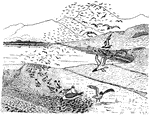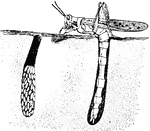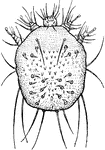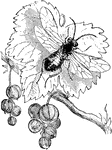Clipart tagged: ‘pest’

Crioceris 12-Punctata
"The mature beetle in life rivals asparagi in beauty, but may be distinguished by its much broader elytra…

Asparagus Beetle
Also known as Crioceris asparagi.Spray of asparagus, with common asparagus beetle in its different stages.…

Bark Beetle
A bark beetle is one of approximately 220 genera with 6,000 species of beetles in the subfamily Scolytinae.…

Adult Common Carpet Beetle
An adult common carpet beetle, a small grayish or black beetle belonging to the order Coleoptera.

Common Carpet Beetle Larva
Larva of the common carpet beetle, a small grayish or black beetle belonging to the order Coleoptera.

Common Carpet Beetle Larva
Larva of the common carpet beetle, a small grayish or black beetle belonging to the order Coleoptera.

Common Carpet Beetle Pupa
Pupa of the common carpet beetle, a small grayish or black beetle belonging to the order Coleoptera.

The Life Cycle of the Asparagus Beetle
Also known as crioceris asparagi. A-Beetle; B-Egg; C-Newly hatched larva; D-Full-grown larva; E-Pupa

Stink Bug
Also known as Stiretrus anchorago. This bug is predatory of the larvae of the Mexican bean beetle and…

Citadel at Perth
Pesth, also known as Pest, and Pesta is the eastern, mostly flat part of Budapest, comprising about…

Common European Cleg (Gadfly)
The common European Cleg is a large, black/blue-black blood-sucking 'horsefly' of the family Tabanidae.…

Fig Insect
"The fig insect will not lay eggs in the Smyrna fig, but only in the wild fig; therefore one individual…

Flea
"Aphaniptera includes the fleas, which, despite their minuteness, have made themselves a name in the…

Human Flea
The human flea (Pulex irritans) is a parasitic insect that actually has several hosts despite its name.

Botfly Larva
"After attaching themselves to the walls of the stomach, the botfly larva are nourished by the blood…

Mature Botfly
"After attaching themselves to the walls of the stomach, the botfly larva are nourished by the blood…

Hessian Fly
The hessian fly or barley midge, Mayetiola destructor, is a species of fly that is a significant pest…
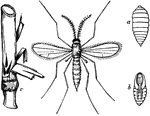
Stages of the Hessian Fly
Now known as Mayetiola destructor: "Hessian Fly (Cecidomyia destructor). a, larva; b, pupa; c, infested…

Gnats
"In the family Culicidae, or Gnats, which include several pre-eminently bloodthirsty species,…

Gooseberry Caterpillar (Nematus ribesii) and Sawfly
Gooseberry Caterpillar is the name applied to the larvæ of two different insects, both injurious to…

Harvest-tick
"The true ticks attach themselves parasitically to the bodies of various mammals, as sheep, oxen, dogs,…

Itch-mite
"Of the true mites, the domestic or cheese mite and the itch-mite are examples." — Williams, 1889
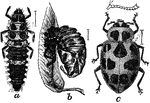
Spotted Ladybird
Also known as megilla maculata. A-Larva; B-Empty skin; C-Beetle with enlarged antenna above.

Locust
"The locusts come down in swarms of millions from the warm lands of southern Brazil. There are so many…

Hop Louse
"Hop louse which lives on the plum tree in the late fall, winter, and early spring until the hop vines…

Cheese mite
"Of the true mites, the domestic or cheese mite and the itch-mite are examples." — Williams, 1889

Mosquitos
"The Mosquitos, Colex musquito, which are very nearly allied to the gnats, are still greater…

Clear-Winged Moth
"These are wasplike moths of brilliant colors and have transparent wings. They generally fly by day."…
The bridge at Pesth
Pesth, also known as Pest, and Pesta is the eastern, mostly flat part of Budapest, comprising about…
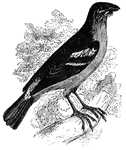
Chilian plant-cutter
The Chilian plant-cutter frequents the wooded parts of the country, where they feed on buds, fruits…

Larvae of Rose Sawfly
A parasite which feeds as larvae in rose-twigs or upon the leaves. Some species are confined to roses…

Pea Weevil
"The pea weevil is often found in peas in its larval state during summer and autumn, as a pupa in winter,…







